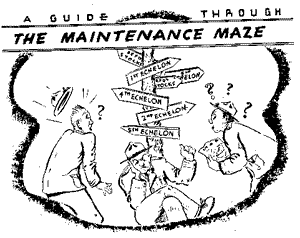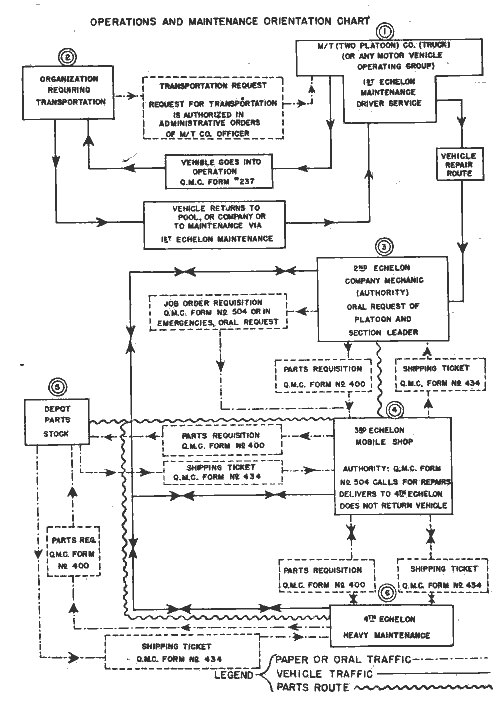
by Howard P. Leary, 1st Lt. Q.M.C. from the WW2 Army Motors
Recently, while trying to point the way on the ‘Echelon System of Maintenance’ to a class of officers attending a refresher course at The Motor Transport School, somebody popped up and asked how the second echelon or company mechanic receives the parts necessary to make repairs. That started the questions rolling and in they came: “How does the unit commander (truck company) or motor pool C/O get authority to dispatch vehicles to a unit needing transportation? What paper work is needed?..”
ECHELON MAINTENANCE
Apparently the echelon system of maintenance is pretty much of a maze and I realized that my ideas weren’t going over. Instead of giving the officers the dope, I was doping then with information that didn’t mean a great deal.
So – I went back to the beginning and started over again. When the dust had settled we came up with the accompanying chart of what happens to vehicles, tools, paper work, etc., when the start roaming from one echelon to another in a motor transport unit. The chart helped us, and other officers of the school, so I am giving it to you with the thought it might help you find yourself in the maintenance maze.
BUILDING THE CHART
We started building the chart by placing on it a motor truck company, No. 1, or motor pool, the operating unit; then came No. 2, the unit requiring transportation. No. 1 had the trucks, No. 2 needed them to move troops. How to get the two together was the problem. Click for larger view, 33K
In motor field operation, the field order issued by the C/O of the division or other tactical unit has an accompanying administrative order covering all details of administration, supply, and evacuation. Thus, by referring to this order, we find that the unit needing transportation, No. 2, would submit a request to the Division Motor Officer (Senior Motor Transport Officer), who is in charge of the operating unit, No. 1.
That settles the request: The vehicles are read and waiting.
PAPERWORK
But wait a minute: We find that some record must be made of the movement and that the driver of the vehicle must have some authority for his trip. AR 850-15 (Military Motor Vehicles), Section IV, tells us that certain forms, records, and other paper work are necessary. No it’s no use having forms and records unless there is someone to take care of them, so we found it necessary to establish a dispatching office. At the operating unit, No. 1, this dispatching office makes up two forms to take care of the request for the unit requiring transportation, No. 2.
One form is WD QMC Form No. 254 (Daily Dispatching Record of Motor Vehicles) on which should be entered all the information pertaining to the movement of vehicles. From this form is made out WD QMC Form No. 237 (Driver’s Trip Ticket and Performance Record), which is the driver’s authority for his trip.
FIRST ECHELON CHECKS
Well, that’s all settled. The vehicle rolls on its way and when it has completed its mission, it returns to the operation unit, No. 1. The driver performs the necessary first echelon routine, and while checking on the oil level in the crankcase finds that the engine has consumed an excessive quantity of oil. He reports this to his section leader, who, in turn, reports it to the platoon leader. The platoon leader orders the truck out of service and reports it to the truckmaster or first sergeant. The first sergeant informs the dispatching office that the truck is out of service and the office removes the vehicle from the pool list.
SECOND ECHELON CHECKS
Apparently there is something wrong with the vehicle, so it is turned over to the second echelon of maintenance, No. 3, or to the company mechanic, who operates under a motor sergeant. The second echelon inspects the vehicle thoroughly and finds that the repairs necessary to correct the excessive oil
consumption are beyond the capacity of the second echelon because a complete replacement or engine overhaul is needed. This fact is reported to the C/O, who starts a WD QMC Form No. 504 (Job Order
Requisition) on its way. The form is sent to the division motor maintenance officer who is in charge of the third echelon of maintenance, No. 4.
THIRD ECHELON WORKS
At the time the requisition is received, the light maintenance company is not very busy and the division motor maintenance officer orders the vehicle delivered to it for repairs. After examining it, the motor officer finds that it will be quicker to replace the engine with another which can be obtained from an adjacent depot parts stock, No. 5, which will allow the vehicle to return promptly to service.
REQUISITION ENGINE
In order to get the engine, he has to fill in WD QMC Form No. 400 (Requisition), ordering one engine assembly of the type needed. The parts depot ships this engine to him on WD QMC Form No. 434 (Shipping Ticket). The light maintenance company place the engine back in the vehicle and sends it on its
way back to the motor pool where it is placed in service in the shortest possible time.
ENGINE OVERHAUL
The engine that was taken out of the vehicle still has to be repaired. It so happens that the third echelon is not equipped to make such unit repairs, so the division motor officer makes out WD QMC Form No. 504 (Job Order Requisition) and forwards this to the fourth echelon, No. 6. When the fourth echelon is ready to receive this engine for repairs, they notify the division motor officer and he sends it to them.
ALTERNATIVE METHOD
Now there is another way that this repair could be handled by the fourth echelon, No. 6. If it so happens to have too much work to do and if, in the opinion of the officer in charge, the third echelon, No. 4, is capable of doing the necessary work, the division motor officer would be told to requisition the parts necessary for the overhaul from the heavy maintenance company, No. 6. The motor officer would make a requisition on WD QMC Form No.400 (Requisition), and the heavy maintenance company, No. 6, would ship the necessary parts to him on WD QMC Form No. 434 (Shipping Ticket)..
HOPE IT HELPS YOU
Of course it’s probably much easier to follow this chart if you start with it from the beginning instead of landing in the middle of it and trying to figure it out from there. I know by the time we finished with it, the blackboard was covered with squares, scribbles, lines showing the various channels through which paper and material flowed, etc. When I stood back and took a gander at the blackboard, I thought perhaps I had confused the class rather than helped them; but no, they all seemed to agree that the chart was much clearer than pages of words could possibly have been.
So, as I said before, I’m turning this chart over to you for what possible advantage you can squeeze out of it.
Hope it helps you!
